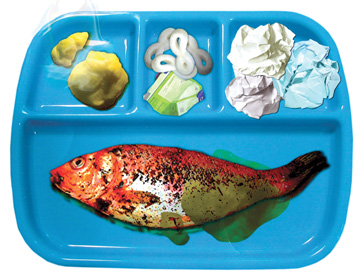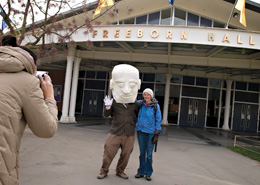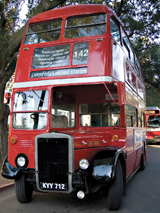Volume 25 · Number 3 · Spring 2008

End Notes
Talking trash
UC Davis design students are trying a new approach to get people on campus to change their trashy behavior: embarrass them.
The students created posters with messages pointed at occupants of four UC Davis buildings that turned up among the worst trash generators in a student-led waste audit earlier this year. The student designers’ goals are to change people’s behavior, help create a greener campus and, at the same time, get real-world experience in the high-demand field of sustainable design.
Tupper Hall, home to veterinary and medical science laboratories, got posters that feature a photo illustration of a plastic dinner tray offering a whole fish coated in industrial waste, with side dishes of packing peanuts and wadded paper.
For Sproul Hall, home to linguistics, the students designed a poster that features an attractive woman beckoning viewers with a double-edged invitation: “Let’s talk trash.”
The poster, designed for posting in the building’s elevator, reveals that Sproul occupants generate enough waste in a month to fill 12 such elevators.
The posters were a class project of students in Associate Professor Ann Savageau’s Design 127 class, with assistance from UC Davis Buildings and Grounds Division Communications Manager Katie Hetrick.
To prick the consciences of the entomologists and other biologists who work in Briggs Hall, the students came up with a poster that features cartoon ants toting crumpled paper balls to a recycling bin. “Ants can lift 20 times their own body weight,” it says. “Why can’t you lift that piece of paper?” For Accounting and Financial Services, posters read: “We’ve audited your waste and you’re in the red.”
Posters went up in December and will remain in place for a year or so. The waste audit will be repeated this spring to test their effectiveness.
— Claudia Morain

Living history: A student public-art project brought a likeness of the late Stanley Freeborn, UC Davisí first chancellor, to campus for a photo opportunity in front of his namesake, Freeborn Hall. Photo: Karin Higgins/UC Davis
Building face
Fourth-year art student Ryan Bulis is way too young to remember Stanley Freeborn. The entomologist, who became UC Davis’ first provost and chancellor, died in 1960 — 23 years before Bulis was even born. But through the power of art and lots of plaster, Bulis and fellow students Serena Monts and Anna Ng recently brought Freeborn and three other campus luminaries back to life to introduce them to a whole new generation of Aggies.
As part of an interdisciplinary course titled “Where Here Is,” taught by associate art professor Robin Hill, the three students made larger-than-life masks of Freeborn, former Chancellor Emil Mrak (1901–87), “father of the Farm” Peter Shields (1862–1962) and student health center namesake Samuel Henry Cowell (1861–1955). Then Bulis donned the heavy masks and posed for Polaroid photos with passersby in front of the buildings named for each of the late leaders.
“The idea was to draw attention to some aspect of campus history that was being overlooked,” Bulis said. “We came to the realization that few people entering Shields Library, Freeborn Hall, Mrak Hall, etc., even knew who these men were. How could they?”
Bulis, Monts and Ng spent a lot of time going through biographies, photos and other documents in Special Collections in the library before making the masks and taking them out for the photo opportunities. They titled their work A Face to a Place.

End of the line
After 57 years and more than 1.25 million miles of service, first in London and then Davis, double-decker bus No. 1014 made its final regular-service route in December. No other bus of its kind in the world has lasted as long on the original engine, said Anthony Palmere, Unitrans assistant general manager.
Unitrans must now decide whether to outfit No. 1014 with a cleaner-burning engine to meet new state emission standards or donate it to a museum.
The transit system has five other double-deckers, two converted to compressed natural gas, two with new diesel engines and the fifth getting a new diesel engine. All of the double-deckers came from London, with the first two arriving in 1967.
The mileage on No. 1014’s engine equals 50 trips around the world, or 118 round trips between London and Davis.
